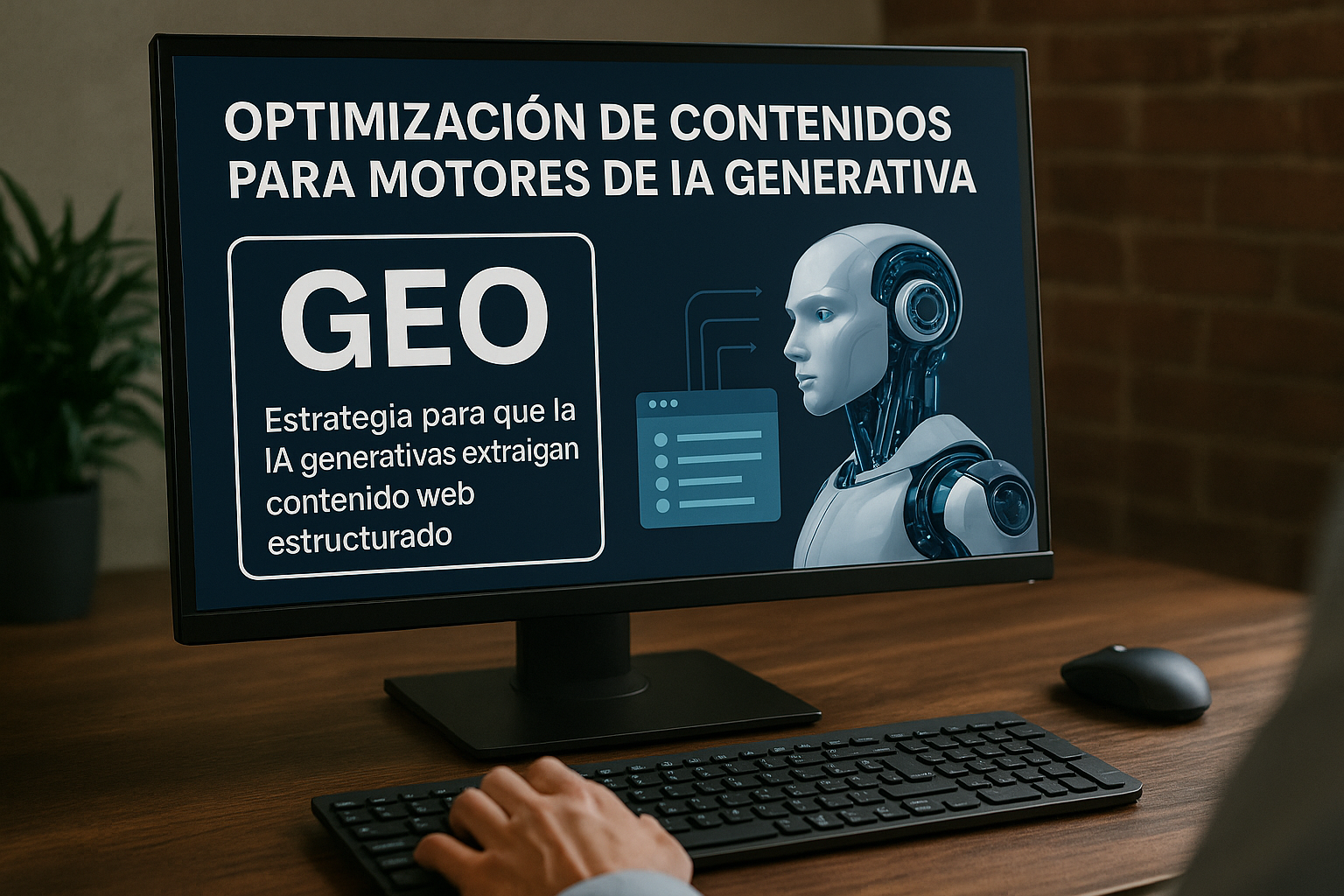In a digital environment that is advancing at breakneck speed, the rules of the game have changed. It is no longer enough to appear on Google: now, if you want your content to have presence and relevance, you need to be in the responses of ChatGPT, Copilot, Gemini or Alexa. To do this, the concept of GEO has been created: Generative Engine Optimisation, the new frontier of digital visibility.
What is GEO?
GEO (Generative Engine Optimisation) is the strategy that allows your content to not only be crawled by traditional search engines, but also read, interpreted, quoted and referenced by generative artificial intelligence models. The goal is not only to improve your search engine ranking, but also to ensure that AI uses your information as a reliable source in its responses to millions of users.
In short: whoever controls AI responses controls the digital conversation.

Why do you need to optimise your content for AI?
Generative AI engines, such as those powering ChatGPT, Bard or Claude, do not display a list of links like Google, but a single integrated response. This means that if your content has not been optimised for AI, your brand may not be mentioned, your information may not be cited and, most worryingly, your competitors’ data may be used instead.
If your business depends on its digital authority, visibility or online lead generation, ignoring GEO today means losing ranking tomorrow.
How does GEO differ from traditional SEO?
SEO (Search Engine Optimisation) and GEO are complementary strategies but with different approaches:
| Aspect | Traditional SEO | GEO (Optimisation for AI) |
| Objective | Improve search engine rankings | Be cited by AI models |
| Main technique | Keywords, backlinks, website speed | Structured data, semantics, authority |
| Success measurement | Clicks, impressions, traffic | AI mentions, accuracy, AI traffic |
GEO focuses on how to structure your content so that it is understandable and reliable for AI, which is now becoming the new digital “influencer”.
How do we optimise content for generative AI engines?
An effective GEO strategy involves:
- Use of structured data (Schema Markup)
AI better understands content that follows clear structures such as frequently asked questions (FAQs), lists, definitions, and tables. - Accurate and well-documented content
AI values consistency, depth, and accuracy. We cite sources, provide context, and avoid ambiguity. - Semantic and contextual optimisation
It is no longer enough to repeat keywords. AI understands relationships between concepts, so it is essential to use both natural and technical language. - Building digital authority
Media mentions, quality links and good reviews help AI trust your content. - Customised AI training (RLHF)
In regulated industries, it is key to train models with verified and representative data to ensure terminological consistency.
How do you measure the success of a GEO strategy?
Unlike SEO, where metrics focus on traffic from Google, in GEO the impact is measured by your presence in AI responses:
- Frequency with which AI mentions your brand.
- Accuracy of the information cited by AI.
- Traffic from apps or assistants that use generative models.
- Growth in digital authority and trust.
What happens if you don’t implement a GEO strategy?
The consequences can be serious:
- Loss of visibility: your content is left out of AI responses.
- Misinformation: AI may use incorrect or outdated information about your brand.
- Competitive disadvantage: other companies that do implement GEO will become leaders in your niche.
We are your ally in GEO optimisation
BBLTranslation, through its specialised division BBL IA, offers a GEO service designed to make your content visible, cited and useful in generative AI engines.
Our services include:
- Audit of current content and detection of GEO opportunities.
- Implementation of structured data (Schema.org, FAQs, lists, definitions).
- Curation and writing of AI-optimised content.
- Multilingual semantic integration for AI (ideal for global companies).
- Continuous measurement of mentions and AI impact (monitoring and analysis).
Thanks to our expertise in technical linguistics, ethical AI and cybersecurity applied to content, we help you lead the way in the new era of generative search.
Frequently asked questions about GEO (FAQ)
What is GEO and what is it for?
GEO (Generative Engine Optimisation) is a strategy for optimising web content so that it can be read, understood and cited by generative artificial intelligence engines such as ChatGPT or Copilot. Its aim is to increase brand visibility in AI-generated responses.
What is the difference between GEO and traditional SEO?
While SEO seeks to improve search engine rankings on Google through keywords and backlinks, GEO focuses on structured data, semantics, and authority so that AI models use the content as a reference in their responses.
How can I tell if my content appears in AI responses?
The success of a GEO strategy is measured by how often your brand or content is cited in AI responses, the accuracy of the information generated, and the traffic derived from these platforms.
What happens if I don’t optimise my content for AI?
Your brand may lose visibility, be replaced by competitors in AI responses, or even be misrepresented or outdated.
What types of companies should apply GEO?
Any company that wants to maintain digital relevance: from law firms to e-commerce businesses, technology companies, or educational institutions. GEO is especially relevant in regulated, technical, or multilingual sectors.
Conclusion
The future of digital positioning is changing. Whereas before you competed to be on the first page of Google, now you compete to be the source that AI models use to respond. And that requires a new strategy: GEO.
Do you want your brand to be present in the answers of the leading AI systems? Contact us and we will help you implement your personalised GEO strategy.




